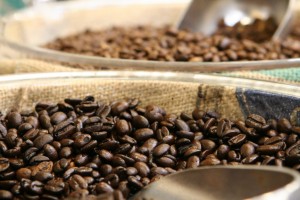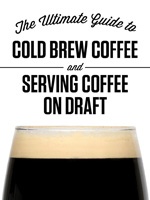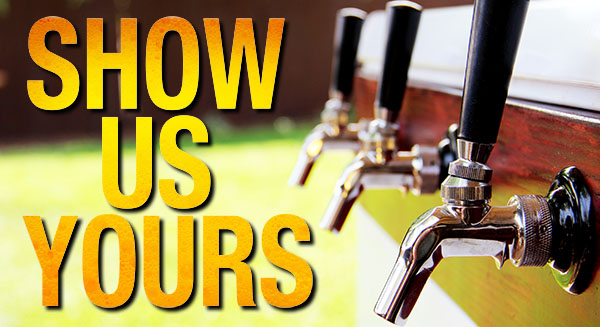 Years ago, I started drinking cold brewed coffee. Why? When I started brewing (beer), I learned that adding hops at different times during the boil produced different chemical reactions – either releasing bitterness, flavor, or aroma. This got me wondering – Could the same apply to coffee?
Years ago, I started drinking cold brewed coffee. Why? When I started brewing (beer), I learned that adding hops at different times during the boil produced different chemical reactions – either releasing bitterness, flavor, or aroma. This got me wondering – Could the same apply to coffee?
Sure enough, after a little bit of research, I came to find out that cold brewing coffee provides a completely different profile than that of traditionally brewed (hot) coffee. Brewing coffee in hot water causes the grounds to release oils, these acidic oils are what gives coffee its bitterness. Cold brewing coffee on the other hand, can take 12-24 hours, but is done at room temperature. Thus, rather than changing the profile of the coffee through chemical reactions, flavor is literally “infused” into the water in which the coffee brews at room temperature.
When you cold brew coffee, you aren’t making a cup or pot of coffee, but rather a coffee concentrate. This coffee concentrate that is produced from cold brewing can be nearly 70 percent less acidic than hot brewed coffee. The reduced acidity makes makes the coffee easier on the stomach and healthier for teeth. Not only that, but you’re getting a smoother, richer coffee taste.
Cold brewed coffee will maintain its taste and flavor profile and not taste like stale day old coffee. Cold brewed coffee concentrate has never been hot, so its chemistry doesn’t change as it cools, meaning its flavor will not change over time. That is the best part… cold brew coffee concentrate can stay fresh for up to 3 weeks!
The cold brewing process makes a very smooth, non-bitter coffee that is great for iced coffee. Cold brewing can also bee used for hot coffee – after cold brewing, simply combine the coffee concentrate with hot water – I personally do about 1:2 ratio of cold brew coffee concentrate to water (1/3 coffee, 2/3 water).
How to Cold Brew Coffee?
Cold brewing coffee is easy, all you’ll need is your coffee grounds of choice and a simple cold brew system – Cold Brew Avenue has a great lineup of cold brew systems. Lastly, if you’re looking to serve iced coffee on tap (full article to come), cold brewed coffee is the way to go. Why? Because with most things that are served on tap, they’ll be stored in a keg (potentially for extended periods of time). If you put hot brewed coffee into a keg, its flavor profile will change as it cools and in the following days. Cold brew coffee maintains a consistent flavor profile and can be kept in a keg for extended periods of time. I keep my cold brewed coffee in a 2.5 gallon keg, but there are plenty of options for storing your cold brew coffee in kegs.
- Combine coffee grounds and water inside your Cold Brew System. Let this sit for 12-24 hours at room temperature.
- Drain the coffee concentrate through the filter into your container. Alternatively, vorlauf your cold brew to get a cleaner final product.
- Keep the coffee concentrate refrigerated for 2-4 weeks. You have high quality coffee on hand at all times now.
- When serving, dilute with water. I typically heat water in a teapot. I’ll pour 1/3 cup of coffee concentrate and add 2/3 hot water from the teapot.
I’ve found that when using coffee concentrate, I use less sugar and less creamer and enjoy much more natural coffee taste. Stay tuned on our future articles about creating cold brew coffee, as well as serving iced coffee on tap. We’ll also explore creating a homebrewed beer using coffee concentrate rather than coffee grounds.
Want to learn more about cold brew coffee and serving coffee on draft?
 Check out our free ebook The Ultimate Guide to Cold Brew Coffee and Serving Coffee on Draft. From brewing small batches to large batches and from serving coffee over ice to nitro coffee using a stout faucet, this book has something for everyone!
Check out our free ebook The Ultimate Guide to Cold Brew Coffee and Serving Coffee on Draft. From brewing small batches to large batches and from serving coffee over ice to nitro coffee using a stout faucet, this book has something for everyone!![]()
Photo from puuikibeach, with Creative Commons attribution.



Hi Brendan,
Thank you for your article about “How to Cold Brew Coffee and Serve Coffee on Tap”. It really gave me a better understanding on how this works. I would like to know if this could also work for Iced tea?
Thank you again.
Kind Regard,
Sara
Hello Brendan,
Thank you for this article right now I am working on opening a mobile coffee shop in a trolley car. I am planing to have teas and cold brew on tap. One of the things I have been playing with is having them in rv water tanks and having keg fitting built in.
http://www.plastic-mart.com/product/230/4-gallon-rv-water-tank-rvb269
Since coffee and tea does not need much pressure to go through the lines. I was wondering what psi you had and if you think my idea makes sense.
Thank you,
Diego Lopez
Hey. I have a small coffee shop and we use Nitrogen and use a psi of 10-15. We just use it as a propulsion system, we do not actually infuse the coffee in our shop.
Hope this helps.
Jenn
Thanks for sharing Jennifer. Many of our clients and the systems we build do the same thing.
Those who are infusing the coffee with nitrogen are generally serving “nitro coffee” out of a stout style faucet so that it pours like a Guinness stout.
Others just use the nitrogen to push the coffee (typically cold brew) from the keg to the faucet to serve over ice.
I am interested in purchasing a cold press coffee system/keg for our cafe in Clarence NY. I am looking for more information on the system, pricing, etc.
Please contact us via our website contact form.
I got my 5 gal keg from the keg outlet and put in my first batch of coffee. Overnight my co2 lost pressure. Any ideas why?
Hi Ryan –
It could have been a loose hose or connection, or the keg lid may not have been seated properly.
When you repressurize, listen to see if you can hear a “hissing” sound. If not, you can try spraying the connections with soapy water to see if you see bubbles anywhere – this will tell you if there is a leak.
We are moving our bakery to new prime location on the HHI. Part of new business will be coffee and juice bar. I would like to ask you to help me to built cold brew station with a nitro option.
Regards Marek Belka
Hi Marek –
I just sent you an email.
Cheers!
Hi there, looking to do cold brew on tap . Need some equipment advice. I have a very small bar area so will need to run the tap line directly below me to the basement where I can fit a kegerator. Not sure how to handle the extra length but can give you an idea of distance and such. Let me know your thoughts. The only equipment I have right now is a cold brew filtron system so I will need the kegs, nitro , refrigerator, lines etc.
Jennilee
nice article. i see that pouring cold brew out of nitro taps is becoming more popular and i recently saw a company that cans their nitro cold brew. do they have a widget ala guinness in the can or do you think they simply charge the bulk cold brew with nitrogen and then pressure can the beverage? thanks for any input!
Hi Henry –
To be honest, I’m not sure about the canning process. I would guess that a “widget” would have to be used to help the coffee retain and pour with a creamy/frothy head, though I’m not 100% sure.
Thanks for the response.
Hi Brendan
Thank you for you article.
We sell coffee in a Farmers market. Can you recommend us any portable kit to serve iced coffee on tap with the option of adding nitrogen.
Thank you again.
Joel c
Do you know how long a nitrogen flushed keg of cold brew would last if stored at room temperature?
Hey Rob – I don’t pretend to be an expert about coffee, but if pressurized with nitrogen, I’d imagine you could get a little more life out of the coffee vs storing it without nitrogen pressure.
That being said, if you’re looking to store a keg of coffee for any extended period of time, your best bet will be to have it refrigerated.
How long are you looking to store this for?
I am also curious about this question. I am looking to probably store about a week tops per keg. Do you think that it would alter or sour the coffee at all without refrigerating?
Hi Phillip – we have yet to try this. I ultimately think it would come down to temperature and whether or not the keg was pressurized. If ambient temp was in the 60s, it would probably be okay, but if you’re in Arizona where temp can be 90-110s, I’d think there’d be some problems there.
If we ever do a small batch test, we’ll be sure to do a writeup about it because this is a question we are getting fairly frequently now.
Cheers!
Hey i was wondering if you had any results from the small batch test?
Hi all,
What is the recommended Filling level when we keg the coffee? Should I leave some space within the keg to allow gas to mix or just fill it all up?
Never keg coffee before, please advice!
@disqus_02O0OEAPXg:disqus When you look inside the keg, you’ll see the long liquid dip tube which goes to the bottom of the keg. On the opposite side, you’ll see the short gas in dip tube. Fill the keg up to just below the gas dip tube. If you fill up to (or beyond) the gas dip tube, this could cause the liquid to push back into the gas line.
in the post you mentioned storing the cold brew in a keg, does the brew stored in the keg have to also be refrigerated?
Seems like a lot of effort just for cold brewed coffee. There are far easier, and less expensive ways to make cold brew. But they do not involve a keg or nitro. I actually prefer the basic Japanese way of making iced coffee by pouring the hot coffee over the ice as cold brew tastes flat and boring to me no matter how I’ve had it.
Hi there. I’m trying to setup a cold brew station on tap for my company and tried a test batch, and after a couple hours of the tank being connected the coffee was coming out almost carbonated. Any suggestions? I have also found this to be an issue with tea too. Something about it being under pressure.
Thanks!
Hi there. Here from Costa Rica.
Im new in this Cold Brew and Nitro Cold Brew Coffee thing.
Im about to make a long batch nitro coffee with a beer master friend o mine. My question is.
I already have the cold brew coffee concentrated, but i dont know in how many parts of water should i have to dilut it. I hope i will find my own recipe but for starting i need some advice and know what you recomend.
Thanks
Hello,,, made my first 3-gallon of cold brew. Put it in keg, pressurized at 30 lbs overnight, using nitrogen. Poured this morning, and got a small head of foam, but definitely not the bubbles that I was expecting. Do I need to leave it pressurize longer? Or any suggestions? It’s at room temperature— does that make a difference? Thx so much….JAM
Hi @joybensonmcadams:disqus – just a couple suggestions….
1 – Cool to serving temperature
2 – Try a Quick Cascade Lid
3 – Try a little more pressure – 35-40psi
Does the quick cascade lid work on the standard cornelius kegs?
Yes it does.
why’s the most cafe don’t make Cold Brew Sparking (Co2) ?
usually made only Nitro Cold Brew.
Hi @disqus_H9Pu0POBbC:disqus – adding CO2 / carbonation to coffee usually makes it very bitter/sour whereas nitrogen has the opposite effect. Nitrogen gives the coffee a sweet/creamy mouthfeel.
So adding Kegerator to our coffee shop for express purpose of cold brew and hopefully Nitro infused as well. Quick question on the difference between the Quick Cascade lid and the “new?” Nitrogen infusers I’ve seen advertised….do they both provide that Guinness look and feel in terms of texture and “head”. Or will I be better off going with a new infuser?
Hey @disqus_H8ib77Y7pY:disqus, thanks for commenting! Yes, so both items will help to acheive the same effect with nitro pours. When serving nitro coffee, you basically have 3 options:
All methods can work equally well, but I think you’ll find that the consistency that you’ll achieve increases as you go down the list above.
Thank you for the quick reply! And on a slightly different note… can I “brew” my cold brew inside of the keg? And then cap it off (sans grounds) for use?
I don’t see why not (assuming you have a way to get the grounds out of the keg after brewing). Just be aware, that as with beer, u less you filter it, you may pull some solids out of the keg with the first few pours.
Got it! Yeah we use cold brew bags….so should be good to go! Closed Sunday/Mon so perfect window to “brew”…. Hot down here in Florida!
👊🏼👍🏼